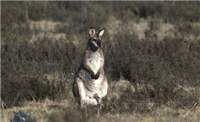Family
Macropodidae
Genus
Macropus
Species
rufogriseus
Threats/Control Methods - Regional
Large-scale forest clearing for urban development or intensive agriculture has reduced the number of wallabies in many areas. Different bushfire patterns from human land management have also had an impact on population numbers. However, population numbers in other agricultural areas have grown, leading to shooting the animal as a crop pest. Fencing off land areas requiring rehabilitation is successful in keeping the grazing pressure off young trees and shrubs.
Threats/Control Methods - Local
The continued land clearing for new Canberra suburbs is decreasing the available habitat space for this species.Common name/s
Red-necked Wallaby, Bennett's Wallaby, Brush Wallaby, Eastern Brush Wallaby, Brush Kangaroo, Brusher, Red Wallaby
Distinguishing Features
The Red-Necked Wallaby has rust red colouring across its shoulders and the back of its neck with the rest of its fur being grey-tan. It is sometimes difficult to see, but the wallaby also has a weak stripe on its face and thigh. The female is slightly paler in colour than the male. The area around the nose and mouth is black, as are the paws and the largest toe.
Similar Species
The Red Kangaroo (Macropus rufus) is considerably larger and leaner than the red-necked wallaby, and the red colouring is spread all over the upper body. In QLD and northern NSW, the Black-striped Wallaby (Macropus dorsalis) is similar, but also has a dark strip down its back and a white hip-stripe.
Distribution
The Red-necked wallaby is present is southeastern Australia, including Queensland, New South Wales, ACT and Tasmania.
Country of Origin
Australia
Survey Techniques
This species was identified during night searches and using scats.
Conservation (Pet/Pest) Status - National
Secure, not listed under the EPBC Act 1999. It is common to abundant in most parts of its range, especially in southern QLD and TAS.
Conservation (Pet/Pest) Status - Regional
Common
LSCCES Population
Common
Associated vegetation community
This species is common in coastal forests and temperate grassy woodland. It has benefited from the partial clearing from grazing in Australia.
Limiting Resources
The Red-necked Wallaby prefers patchy landscape in which it can find suitable vegetation for shelter as well as open grasslands for grazing.
Breeding
Females of this species give birth at any time of year on the Australian mainland. Like all members of the kangaroo (macropodidae) family, joeys are born extremely small and spend the first period of their life in the mother's pouch. After 9 months, the joey will become almost completely independent and spend all its time outside of the pouch. Joeys continue suckling until they are fully weaned by 12- 17 months. By this time, the mother may already have a new baby.
Behaviour
The Red-necked Wallaby is normally a solitary animal, spending its days alone under shady trees. However, it can be seen in groups of up to 30 in areas of good grazing vegetation, emerging from the forest areas in the late afternoon and being most active after dark.
Functional Group
Food Species
Members of the Kangaroo (Macropodidae) family are primarily grass and leaf eaters. They also eat shrubs and herbs. Their ability to convert dry grass into energy-giving glucose explains their success at living in so many parts of Australia.
Predators
Dingoes (Canis lupus), snakes and birds of prey will attack this species and kill the young. They have been killed in small numbers as crop pests in the past.
Interesting Fact
The Kangaroo (macropodidae) family has the unique ability to produce two different kinds of milk simultaneously, to feed both her young over the same time period. The Red-Necked Wallaby in TAS has a well-defined breeding season, and can delay the birth of a fertilized egg for up to 8 months to fit into this time frame.
References - (reader suitability of references, P=Primary teachers, S=Secondary students, T=Tertiary students and researchers)
Books:
Straham, R. 1983. The Australian Museum Complete Book of Australian Mammals. The National Photographic Index of Australian Wildlife. Angus and Robertson Publishers. Sydney. P, S, T
Online Publications:
Tidemann, C., Roscoe, T. and Mitchell, B. 2006. Mammals of the Lower Sullivans Creek Catchment, Canberra ACT. Prepared for the Life in the Suburbs project using data from the Lower Sullivans Creek Catchment Ecological Survey (LSCCES). Australian National University. Canberra. [online]. Available at: http://www.lifeinthesuburbs.com.au/category.php?id=65 S, T
NSW National Parks and Wildlife Service. 2005. Kangaroos and Wallabies. Department of Environment and Conservation (NSW). [online]. Available at:
http://www.nationalparks.nsw.gov.au/npws.nsf/Content/Kangaroos+and+wallabies P, S, T
Researchers: Hedda Ranson-Elliott and Naomi Hogan

 Top
Top Top
Top